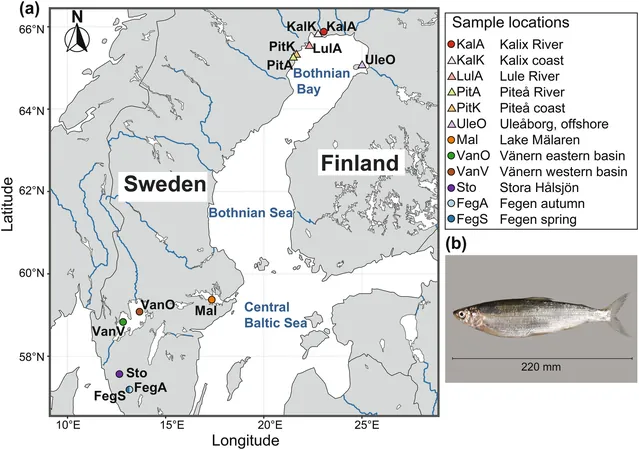
The Surprising Secrets of European Cisco: Genetic Mastery in Changing Waters!
2025-09-22
Author: Li
Unraveling the Mysteries of European Cisco
European cisco roe is a celebrated delicacy, and a groundbreaking study reveals that these fish possess remarkable genetic adaptations to various aquatic environments in Swedish waters. Found in fresh, saline, and brackish waters, these genetically diverse populations also exhibit unique spawning behaviors.
A Collaborative Effort
This fascinating research, a collaboration among esteemed institutions including Uppsala University, the Swedish University of Agricultural Sciences, and others, was recently published in *Molecular Ecology*. The study sheds light on how subtle genetic variations could lead to significant differences in spawning times and habitats.
Three Distinct Variants
European cisco belongs to a small family of salmonids with three distinct variants. The freshwater variant thrives in lakes such as Lake Vänern and Lake Mälaren, while the anadromous version migrates from the Gulf of Bothnia to spawn in freshwater, similar to salmon. The third type, which reproduces in the brackish waters of the Gulf of Bothnia, yields the most prized roe.
Mapping the Genetic Landscape
Kerstin Lindblad-Toh, a professor at Uppsala University, highlighted, "We’ve created a reference atlas detailing the entire genome of the European cisco. This work not only aids our understanding of individual species but also how they relate to distinct populations across varying habitats.” Leif Andersson, the study's lead, echoed the sentiment, emphasizing the importance of this genetic knowledge for sustainable food production.
Historical Separation Revealed
The research uncovered two primary groups of European cisco in Sweden: one in the southern Swedish highlands and another scattered throughout the remainder of the country. These groups likely originated from populations separated during the last Ice Age, leading to distinct adaptations.
Spawn Timing Matters!
The study also found significant genetic differences related to spawning times. Most European cisco typically spawn in the autumn, but a unique spring-spawning population resides in Lake Fegen, straddling the provinces of Västergötland and Småland. This discovery opens exciting avenues for further research.
Genetics and Salinity Tolerance
Notably, many genetic differences between populations were already linked to salinity tolerance in other species. Additionally, researchers identified genes associated with circadian rhythms significantly prevalent among spring-spawning and autumn-spawning populations, further illustrating the complexity of these adaptations.
Future Implications for Roe Quality
Andersson concluded, "Our findings show marked genetic differentiation between the anadromous European cisco of the Kalix River and those spawning in brackish waters. Understanding the connection between spawning environments and roe quality could revolutionize how we manage these vital fish populations in the future."





 Brasil (PT)
Brasil (PT)
 Canada (EN)
Canada (EN)
 Chile (ES)
Chile (ES)
 Česko (CS)
Česko (CS)
 대한민국 (KO)
대한민국 (KO)
 España (ES)
España (ES)
 France (FR)
France (FR)
 Hong Kong (EN)
Hong Kong (EN)
 Italia (IT)
Italia (IT)
 日本 (JA)
日本 (JA)
 Magyarország (HU)
Magyarország (HU)
 Norge (NO)
Norge (NO)
 Polska (PL)
Polska (PL)
 Schweiz (DE)
Schweiz (DE)
 Singapore (EN)
Singapore (EN)
 Sverige (SV)
Sverige (SV)
 Suomi (FI)
Suomi (FI)
 Türkiye (TR)
Türkiye (TR)
 الإمارات العربية المتحدة (AR)
الإمارات العربية المتحدة (AR)